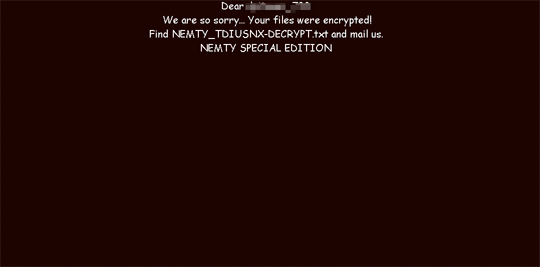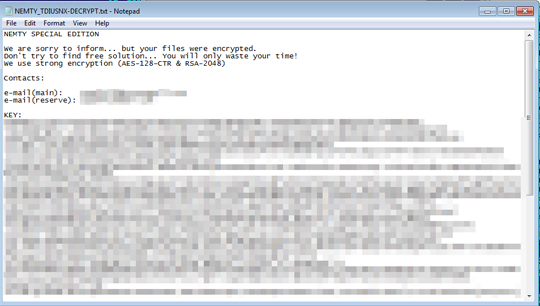Ransom.Win32.NEMTY.THEOGBO
Ransom:Win32/NemptyCrypt.SK!MTB (MICROSOFT); Ransom.Nemty.S13121375 (QUICKHEAL)
Windows


Threat Type: Ransomware
Destructiveness: No
Encrypted:
In the wild: Yes
OVERVIEW
Downloaded from the Internet
This Ransomware arrives on a system as a file dropped by other malware or as a file downloaded unknowingly by users when visiting malicious sites.
It encrypts files found in specific folders. It drops files as ransom note. It avoids encrypting files with the following file extensions.
TECHNICAL DETAILS
214,528 bytes
EXE
Yes
28 May 2020
Displays message/message boxes, Encrypts files, Connects to URLs/IPs
Arrival Details
This Ransomware arrives on a system as a file dropped by other malware or as a file downloaded unknowingly by users when visiting malicious sites.
Installation
This Ransomware adds the following processes:
- %System%\cmd.exe ipconfig
- %System%\cmd.exe net user
(Note: %System% is the Windows system folder, where it usually is C:\Windows\System32 on all Windows operating system versions.)
It adds the following mutexes to ensure that only one of its copies runs at any one time:
- off white air force cveta kapusti :)
Other System Modifications
This Ransomware changes the desktop wallpaper by modifying the following registry entries:
HKEY_CURRENT_USER\Control Panel\Desktop
Wallpaper = %User Temp%\god.jpg
It sets the system's desktop wallpaper to the following image:
- %User Temp%\god.jpg

Download Routine
This Ransomware downloads the file from the following URL and renames the file when stored in the affected system:
- http://ocsp.{BLOCKED}i.goog/gsr2/ME4wTDBKMEgwRjAJBgUrDgMCGgUABBTgXIsxbvr2lBkPpoIEVRE6gHlCnAQUm%2BIHV2ccHsBqBt5ZtJot39wZhi4CDQHjtJ13zfQMBhkWtuM%3D
- http://ocsp.{BLOCKED}i.goog/gts1d2/MFEwTzBNMEswSTAJBgUrDgMCGgUABBT4YwNSyUnwC88de5a5l4eUO%2BLQewQUsd0yXei3N3LSzlzOJv5HeeIBCOkCEFuEnqWAwrdaCgAAAAAl4Dc%3D
- http://api.{BLOCKED}p.com/v2/free/{external ip}/countryName
It saves the files it downloads using the following names:
- %Temporary Internet Files%\Content.IE5\{7 random characters}\raw[1].txt
- %Temporary Internet Files%\Content.IE5\{7 random characters}\countryName[1].txt
- %User Temp%\ip.txt
- %User Temp%\country.txt
(Note: %Temporary Internet Files% is the Temporary Internet Files folder, which is usually C:\Documents and Settings\{user name}\Local Settings\Temporary Internet Files on Windows 2000(32-bit), XP, and Server 2003(32-bit), or C:\Users\{user name}\AppData\Local\Microsoft\Windows\Temporary Internet Files on Windows Vista, 7 and 2008(64-bit), or C:\Users\{user name}\AppData\Local\Microsoft\Windows\INetCache on Windows 8, 8.1, 2012(64-bit) and 10(64-bit).. %User Temp% is the current user's Temp folder, which is usually C:\Documents and Settings\{user name}\Local Settings\Temp on Windows 2000(32-bit), XP, and Server 2003(32-bit), or C:\Users\{user name}\AppData\Local\Temp on Windows Vista, 7, 8, 8.1, 2008(64-bit), 2012(64-bit) and 10(64-bit).)
Other Details
This Ransomware adds the following registry keys:
HKEY_CURRENT_USER\Software\TESORION
fileid = NEMTY_{7 random characters}
It connects to the following URL(s) to get the affected system's IP address:
- www.myexternalip.com
It drops the following file(s)/component(s):
- %Cookies%\{username}@db-ip[1].txt
(Note: %Cookies% is the Internet Explorer browser cookies folder, which is usually C:\Documents and Settings\{user name}\Cookies on Windows 2000(32-bit), XP, and Server 2003(32-bit), or C:\Users\{user name}\AppData\Roaming\Microsoft\Windows\Cookies on Windows Vista and 7, or C:\Users\{user name}\AppData\Local\Microsoft\Windows\INetCookies on Windows 8, 8.1, 2008(64-bit), 2012(64-bit) and 10(64-bit).)
Ransomware Routine
This Ransomware encrypts files found in the following folders:
- Removable Drive
- Network Drive
- Fixed Drive
It avoids encrypting files with the following strings in their file path:
- windows
- $RECYCLE.BIN
- NTDETECT.COM
- MSDOS.SYS
- IO.SYS
- boot.ini
- AUTOEXEC.BAT
- ntuser.dat
- desktop.ini
- CONFIG.SYS
- RECYCLER
- BOOTSECT.BAK
- bootmgr
- programdata
- appdata
- program files
- program files (x86)
It appends the following extension to the file name of the encrypted files:
- (encrytpted files}.NEMTY_{7 random characters}
It drops the following file(s) as ransom note:
- {Encrypted File Directory}\NEMTY_{7 random characters}-DECRYPT.txt

It avoids encrypting files with the following file extensions:
- .exe
- .log
- .cab
- .cmd
- .com
- .cpl
- .ini
- .dll
- .url
- .ttf
- .mp3
- .pif
- .mp4
- .NEPHILIM
- .msi
- .lnk
- .NEMTY
SOLUTION
9.850
15.896.07
28 May 2020
15.897.00
29 May 2020
Step 1
Trend Micro Predictive Machine Learning detects and blocks malware at the first sign of its existence, before it executes on your system. When enabled, your Trend Micro product detects this malware under the following machine learning name:
- Troj.Win32.TRX.XXPE50FFF035
Step 2
Before doing any scans, Windows 7, Windows 8, Windows 8.1, and Windows 10 users must disable System Restore to allow full scanning of their computers.
Step 3
Note that not all files, folders, and registry keys and entries are installed on your computer during this malware's/spyware's/grayware's execution. This may be due to incomplete installation or other operating system conditions. If you do not find the same files/folders/registry information, please proceed to the next step.
Step 4
Restart in Safe Mode
Step 5
Delete this registry key
Important: Editing the Windows Registry incorrectly can lead to irreversible system malfunction. Please do this step only if you know how or you can ask assistance from your system administrator. Else, check this Microsoft article first before modifying your computer's registry.
- In HKEY_CURRENT_USER\Software\TESORION
- fileid = "NEMTY_{7 random characters}"
- fileid = "NEMTY_{7 random characters}"
Step 6
Delete this registry value
Important: Editing the Windows Registry incorrectly can lead to irreversible system malfunction. Please do this step only if you know how or you can ask assistance from your system administrator. Else, check this Microsoft article first before modifying your computer's registry.
- In HKEY_CURRENT_USER\Control Panel\Desktop
- Wallpaper = "%User Temp%\god.jpg"
- Wallpaper = "%User Temp%\god.jpg"
Step 7
Search and delete these files
- %Temporary Internet Files%\Content.IE5\{7 random characters}\raw[1].txt
- %Temporary Internet Files%\Content.IE5\{7 random characters}\countryName[1].txt
- %User Temp%\ip.txt
- %User Temp%\country.txt
- %Cookies%\{username}@db-ip[1].txt
- {Encrypted File Directory}\NEMTY_{7 random characters}-DECRYPT.txt
- {Encrypted File}.NEMTY_{7 random characters}
- %User Temp%\god.jpg
Step 8
Reset your Desktop properties
Step 9
Restart in normal mode and scan your computer with your Trend Micro product for files detected as Ransom.Win32.NEMTY.THEOGBO. If the detected files have already been cleaned, deleted, or quarantined by your Trend Micro product, no further step is required. You may opt to simply delete the quarantined files. Please check this Knowledge Base page for more information.
Step 10
Scan your computer with your Trend Micro product to delete files detected as Ransom.Win32.NEMTY.THEOGBO. If the detected files have already been cleaned, deleted, or quarantined by your Trend Micro product, no further step is required. You may opt to simply delete the quarantined files. Please check the following Trend Micro Support pages for more information:
Step 11
Restore encrypted files from backup.
Did this description help? Tell us how we did.

